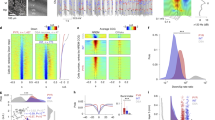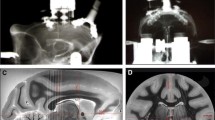Summary
A total of 260 neurons were recorded in the rostral pontine tegmentum of freely moving cats during the sleep-waking cycle. Of these, 207 neurons (80%) were located in the dorsal pontine tegmentum containing monoaminergic and choline acetyltransferase (ChAT)-immunoreactive, or cholinergic neurons. In addition to presumably monoaminergic PS-off cells (n = 51) showing a cessation of discharge during paradoxical sleep (PS) and presumably cholinergic PGO-on cells (n = 40) exhibiting a burst of discharge just prior to and during ponto-geniculo-occipital (PGO) waves, we observed tonic (n = 108) and phasic (n = 61) neurons exhibiting, respectively, tonic and phasic patterns of discharge during wakefulness and/or paradoxical sleep. Of 87 tonic cells histologically localized in the dorsal pontine tegmentum rich in cholinergic neurons, 46 cells (53%) were identified as giving rise to ascending projections either to the intralaminar thalamic complex (n = 26) or to the ventrolateral posterior hypothalamus (n = 13) or to both (n = 9). Two types of tonic neurons were distinguished: 1) tonic type I neurons (n = 28), showing a tonic pattern and high rates of discharge during both waking and paradoxical sleep as compaired with slow wave sleep; and 2) tonic type II neurons (n = 20), exhibiting a tonic pattern of discharge highly specific to the periods of paradoxical sleep. Tonic type I neurons were further divided into two subclasses on the basis of discharge rates during waking: a) rapid (Type I-R; n = 17); and b) slow (Type I-S; n = 11) units with a discharge frequency of more than 12 spikes/s or less than 5 spikes/s, respectively. Like monoaminergic PS-off and cholinergic PGO-on cells, both tonic type II and type I-S cells were characterized by a long spike duration (median: 3.3 and 3.5 ms), as well as by a slow conduction velocity (median: 1.8 and 1.7 m/s). In the light of these data, we discuss the possible cholinergic nature and functional significance of these ascending tonic neurons in the generation of neocortical electroencephalographic desynchronization occurring during waking and paradoxical sleep.
Similar content being viewed by others
References
Armstrong DM, Saper CB, Levey AL, Wainer BH, Terry RD (1983) Distribution of cholinergic neurons in rat brain: demonstrated by the immunohistochemical localization of choline acetyltransferase. J Comp Neurol 216:53–68
Aston-Jones G, Shaver R, Dinan T (1984) Cortically projecting nucleus basalis neurons in rat are physiologically heterogeneous. Neurosci Lett 46:19–24
Batsel HL (1960) Electroencephalographic synchronization and desynchronization in the chronic “cerveau isolé” of the dog. Electroenceph Clin Neurophysiol 12:421–430
De Lima AD, Singer W (1987) The brainstem projection to the lateral geniculate nucleus in the cat: identification of cholinergic and monoaminergic elements. J Comp Neurol 259:92–121
Dutar P, Rascol O, Jobert A, Lamour Y (1986) Comparison of septo-hippocampal and basalo-cortical projection neurons in the cat: an electrophysiological approach. Neurosci Lett 63:86–90
Fuller JH (1975) Brain stem reticular units: some properties of the course and origin of the ascending trajectory. Brain Res 83:349–367
Glenn LL, Steriade M (1982) Discharge rate and excitability of cortically projecting intralaminar thalamic neurons during waking and sleep states. J Neurosci 10:1387–1404
Godfraind JM (1975) Micro-electrophoretic studies in the cat pulvinar region: effect of acetylcholine. Exp Brain Res 22:243–254
Graybiel AM (1977) Direct and indirect preoculomotor pathway of the brainstem: an autoradiographic study of the pontine reticular formation in the cat. J Comp Neurol 175:37–78
Graybiel AM, Berson BM (1980) Histochemical identification and afferent connections of subdivisions in the lateralis-posterior-pulvinar complex and related thalamic nuclei in the cat. Neuroscience 5:1175–1238
Hallanger A, Levey AI, Lee HJ, Rye DB, Wainer BW (1987) The origins of cholinergic and other subcortical afferents to the thalamus in the rat. J Comp Neurol 262:105–124
Hobson JA (1965) The effect of chronic brain stem lesions on cortical and muscular activity during sleep and waking in the cat. Electroenceph Clin Neurophysiol 19:41–62
Hoover DB, Muth EA, Jacobowitz DM (1978) A mapping of the distribution of acetylcholine, choline acetyltransferase and acetylcholinesterase in discrete areas of rat brain. Brain Res 153:295–306
Houser CR, Crawford GD, Barber RP, Salvaterra PM, Vaughn JE (1983) Organization and morphological characteristics of cholinergic neurons: an immunohistochemical study with a monoclonal antibody to choline acetyltransferase. Brain Res 266:97–119
Isaacson LG, Tanaka D Jr (1986) Cholinergic and non-cholinergic projections from the canin pontomesencephalic tegmentum (Ch5 area) to the caudal intralaminar thalamic nuclei. Exp Brain Res 62:179–188
Jones BE, Beaudet A (1987) Distribution of acetylcholine and catecholamine neurons in the cat brain stem: a choline acetyltransferase and tyrosine hydroxylase immunohistochemical study. J Comp Neurol 261:15–32
Jouvet M (1962) Recherches sur les structures nerveuses et les mécanismes responsables des différentes phases du sommeil physiologique. Arch Ital Biol 100:125–206
Jouvet M (1972) The role of monoamines and acetylcholinecontaining neurons in the regulation of sleep-waking cycle. Ergebn Physiol 64:166–307
Kayama Y, Ogawa T (1987) Electrophysiology of ascending, possibly cholinergic neurons in the rat laterodorsal tegmental nucleus: comparison with monoamine neurons. Neurosci Lett 77:277–282
Kimura H, McGeer JH, McGeer EG (1981) The central cholinergic systems studied by choline acetyltransferase immunohistochemistry in the cat. J Comp Neurol 200:151–201
Krnjevic K (1974) Chemical nature of synaptic transmission in vertebrates. Physiol Rev 54:418–540
Lamour Y, Dutar P, Robert A (1984) Septo-hippocampal and other medial septum-diagonal band neurons: electrophysiological and pharmacological properties. Brain Res 309:227–239
Levey AI, Hallanger AE, Wainer BH (1987) Choline acetyltransferase immunoreactivity in the rat thalamus. J Comp Neurol 257:317–332
Lin JS, Sakai K, Vanni-Mercier G, Jouvet M (1989) A critical role of the posterior hypothalamus in the mechanisms of wakefulness determined by microinjection of muscimol in freely moving cats. Brain Res 479:225–240
Lindsley DB, Schneider LH, Knowles WB, Magoun HW (1950) Behavioral and EEG changes following chronic brain stem lesions in the cat. Electroenceph Clin Neurophysiol 2:483–493
Marshal KC, Murray JS (1980) Cholinergic facilitation of thalamic relay transmission in the cat. Exp Neurol 69:318–333
Mesulam MM, Mufson EJ, Wainer BH, Levey AI (1983) Central cholinergic pathways in the rat: an overview based on an alternative nomenclature (Ch1–Ch6). Neuroscience 10:1185–1201
Mesulam MM, Mufson EJ, Levey AI, Wainer BH (1984) Atlas of cholinergic neurons in the forebrain and upper brainstem of the macaque based on monoclonal choline acetyltransferase immunohistochemistry and acetylcholinesterase histochemistry. Neuroscience 12:669–686
Mizukawa K, McGeer PL, Tago H, Peng JH, McGeer EG, Kimura H (1986) The cholinergic system of the human hind-brain studied by choline acetyltransferase immunohistochemistry and acetylcholinesterase histochemistry. Brain Res 379:39–55
Moruzzi G, Magoun HW (1949) Brain stem reticular formation and activation of the EEG. Electroenceph Clin Neurophysiol 1:455–473
Moruzzi G (1972) The sleep-waking cycle. Ergebn Physiol 64:1–165
Naquet R, Denavit M, Lanoir J, Albe-Fessard D (1965) Altérations transitoires ou définitives de zones diencéphaliques chez le chat: leurs effets sur l'activité électrique corticale et le sommeil. In: Jouvet M (ed) Aspects anatomo-fonctionnels de la physiologie du sommeil. CNRS, Paris, pp 107–131
Nauta HJW (1979) Projections of the pallidal complex: an autoradiographic study in the cat. Neuroscience 4:1853–1873
Paré D, Smith Y, Parent A, Steriade M (1988) Projections of brainstem core cholinergic and non-cholinergic neurons of cat to intralaminar and reticular thalamic nuclei. Neuroscience 25:69–86
Phillis JW (1976) Acetylcholine and synaptic transmission in the central nervous system. In: Hoekman CH, Bieger D (eds) Chemical transmission in the mammalian central nervous system. University Park Press, Baltimore, pp 159–213
Reiner PB, Semba K, Fibiger HC, McGeer EG (1987) Physiological evidence for subpopulations of cortically projecting basal forebrain neurons in the anesthetized rat. Neuroscience 20:629–636
Ropert N, Steriade M (1981) Input-output organization of the midbrain reticular core. J Neurophysiol 46:17–31
Sakai K (1980) Some anatomical and physiological properties of pontomesencephalic tegmental neurons with special reference to the PGO waves and postural atonia during paradoxical sleep. In: Hobson JA, Brazier MAB (eds) The reticular formation revisited. Raven Press, New York, pp 427–447
Sakai K, Jouvet M (1980) Brain stem PGO-on cells projecting directly to the cat dorsal lateral geniculate nucleus. Brain Res 194:500–505
Sakai K (1985a) Anatomical and physiological basis of paradoxical sleep. In: McGinty DJ et al. (eds) Brain mechanisms of sleep. Raven Press, New York, pp 111–137
Sakai K (1985b) Neurons responsible for paradoxical sleep. In: Wauquier et al. (eds) Sleep: neurotransmitters and neuromodulators. Raven Press, New York, pp 29–42
Sakai K, Luppi PH, Salvert D, Kimura H, Maeda T, Jouvet M (1986) Localization of cholinergic neurons in the cat lower brain stem. C R Acad Sci (Paris) 78:317–324
Sakai K (1988) Executive mechanisms of paradoxical sleep. Arch Ital Biol 126:239–257
Satoh K, Fibiger HC (1985) Distribution of central cholinergic neurons in the baboon (Papio papio). II. A topographic atlas correlated with catecholamine neurons. J Comp Neurol 236:215–233
Satoh K, Fibiger HC (1986) Cholinergic neurons of the laterodorsal tegmental nucleus: efferent and afferent connections. J Comp Neurol 253:277–302
Semba K, Reiner PB, McGeer EG, Fibiger HC (1988) Brainstem afferents to the magnocellular basal forebrain studied by axonal transport, immunohistochemistry, and electrophysiology in the rat. J Comp Neurol 267:433–453
Shute CCD, Lewis PR (1967) The ascending cholinergic reticular system: neocortical, olfactory and subcortical projections. Brain 90:497–520
Sofroniew MV, Priestley JV, Consolazione A, Eckenstein F, Cuello AC (1985) Cholinergic projections from the midbrain and pons to the thalamus in the rat, identified by combined retrograde tracing and choline acetyltransferase immunohistochemistry. Brain Res 329:213–223
Steriade M (1981) Mechanisms underlying cortical activation: neuronal organization and properties of the midbrain reticular core and intralaminar thalamic nuclei. In: Pompeiano O, Ajmone-Marsan C (eds) Brain mechanisms of perceptual awareness. Raven Press, New York, pp 327–377
Steriade M, Glenn LL (1982) Neocortical and caudate projections of intralaminar thalamic nuclei neurons and their synaptic excitation from midbrain reticular core. J Neurophysiol 48:352–371
Steriade M, Oakson G, Ropert N (1982) Firing rates and patterns of midbrain reticular neurons during steady and transitional states of the sleep-waking cycle. Exp Brain Res 46:37–51
Steriade M, Sakai K, Jouvet M (1984) Bulbo-thalamic neurons related to thalamocortical activation processes during paradoxical sleep. Exp Brain Res 54:463–475
Steriade M, Paré D, Parent A, Smith Y (1988) Projections of cholinergic and non-cholinergic brainstem reticular neurons to relay and associational thalamic nuclei in the cat and macaque monkey. Neuroscience 25:47–67
Vanderwolf CH, Stewart DJ (1988) Thalamic control of neocortical activation: a critical re-evaluation. Brain Res Bull 20:529–538
Vanni-Mercier G, Sakai K, Jouvet M (1984) Neurones spécifiques de l'éveil dans l'hypothalamus postérieur du chat. C R Acad Sci (Paris) 298:195–200
Villablanca J (1965) The electroencephalogram in the chronic cerveau isolé cat. Electroenceph Clin Neurophysiol 19:576–586
Vincent SR, Reiner P (1987) The immunohistochemical localization of choline acetyltransferase in the cat brain. Brain Res Bull 18:371–415
Webster HH, Jones BE (1988) Neurotoxic lesions of the dorsolateral pontomesencephalic tegmentum-cholinergic cell area in the cat. II. Effects upon sleep-waking states. Brain Res 458:285–302
Woolf NJ, Butcher LL (1986) Cholinergic systems in the rat brain. III. Projections from the pontomesencephalic tegmentum to the thalamus, tectum, basal ganglia and basal forebrain. Brain Res Bull 16:603–637
Author information
Authors and Affiliations
Rights and permissions
About this article
Cite this article
El Mansari, M., Sakai, K. & Jouvet, M. Unitary characteristics of presumptive cholinergic tegmental neurons during the sleep-waking cycle in freely moving cats. Exp Brain Res 76, 519–529 (1989). https://doi.org/10.1007/BF00248908
Received:
Accepted:
Issue Date:
DOI: https://doi.org/10.1007/BF00248908




